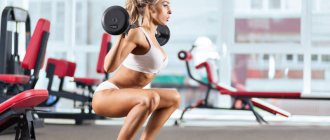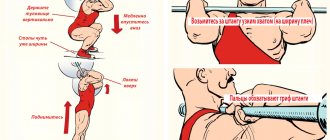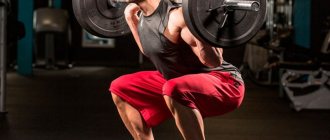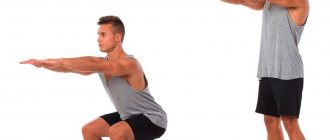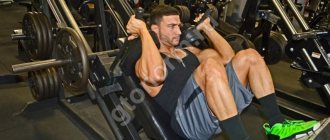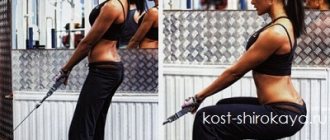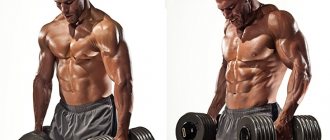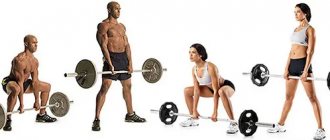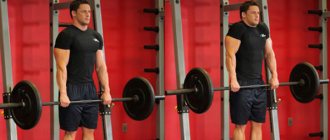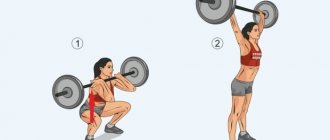Squats with a barbell are one of the important physical exercises for general pumping of the lower body. While performing this exercise, the muscles of the legs, buttocks, and abs are used; in addition, the stabilizer muscles of the core and spine become toned. Many people do not know how to squat with a barbell correctly, but without this exercise it is impossible to create a toned body.
Purpose of the exercise
Squats are, of course, important for the overall development of a person's muscular structure and form the basis for lower body training. The legs and buttocks are pumped, and the stabilizer muscles of the core and spine are also strengthened. Thanks to this exercise, posture improves and the chest expands, which harmonizes the appearance of the athlete.
Research has shown that the heavy barbell squat improves and optimizes hormone levels, specifically affecting testosterone growth in men. This fact contributes to the fact that muscle mass grows faster and the libido of the stronger sex increases significantly.
Another factor for starting barbell squats is the formation of neuromuscular connections, since during the squat a person must control the hip, knee and ankle joints.
Standards
Barbell squat standards are divided into different categories. First of all, the weight of the barbell depends on the gender of the athlete. Next comes the division by level of activity. This criterion distinguishes between amateurs and professionals. After this, the weight is determined by the bit grid.
It is divided into ascending categories:
- Third.
- Second.
- First.
- Candidate Master of Sports.
- Master of Sport.
- Master of Sports of international class.
- Elite.
It also contains weight categories from 44 to more than 90 kilograms for professional women and from 52 to more than 140 for men of the same category .
The weight of the load for the squat is determined based on the weight of the athlete and the discharge performed. It starts from 100 kilograms for men with a minimum weight and category and from 62.5 kilograms for women. The maximum load in the men's and women's nets is 365 and 240 kilograms, respectively.
Pros and cons of performing barbell squats
Like all training exercises, the barbell squat has its advantages and disadvantages that are worth considering.
Benefits for the body
It is extremely important for every athlete to work out maximum muscles in a short time. The reality of athletes is that a person who does 3-4 working sets of 10 repetitions with a large weight will be physically built much better than his opponent, who hangs out in the gym for one and a half to two hours, but does only sluggish flexions and extensions, and so on. , perhaps some platform leg press exercises.
For athletes, such an exercise is very useful, because... allows you not only to strengthen the body, but also to improve its health.
- General muscle building. The back grows a lot from squats, so this exercise creates a beautiful body.
- Legs become stronger, which allows you to participate in all sports disciplines. Football players, wrestlers, mixed martial arts fighters squat with a barbell. Even if these are not heavy weights, like those used by professionals, they are quite enough to strengthen muscles.
- Power squats with a barbell are ideal for injury prevention.
- Changes the shape of the gluteal muscle and legs. It's almost impossible to find a leg workout without squats - it's the basis of everything.
- Development of the overall strength of the athlete. Because it is in this exercise that the core muscles work.
- Improves blood supply to the pelvic organs, increases bone strength.
- A large amount of fat is burned during training.
If a beginner has started doing the squat with a barbell, then opinions about the benefits of this exercise differ slightly. If you train with light weights, joint mobility improves, coordination increases and ligaments are significantly strengthened. If you do the correct squat without strain, you will avoid injury. The other side of the argument is that beginners are too weak in their muscles and will not perform squats correctly due to their inability to support the weight of the barbell on their back.
Girls often choose exercise for the sake of beautiful buttocks and thighs.
It is advisable to pump up all the muscles in the gym before such an exercise, but you should not delay this for six months. It is enough to gain experience and strengthen your muscles, and then move on to squats with a barbell.
Harm and contraindications
Even an absolutely healthy person who squats with a barbell without any preliminary training can develop protrusion or herniation of the spine.
Preparation for such an exercise lasts about 2-3 months, first you need to squat with a light weight (maximum 10 kg), and also perform a full range of training to generally strengthen the muscles, especially the muscles that support the spine and abdominals.
The result of squats directly depends on the proportions of the human body, especially on the ratio of the thigh to the lower leg. Also, unstretched athletes experience severe shoulder discomfort when placing the bar on their back.
There are also features of the spinal column in which a person cannot straighten up and move the pelvis back. This ratio of long thigh to short lower leg forces the athlete to lean forward too much when squatting, which is extremely uncomfortable.
Squats with a barbell are contraindicated if:
- severe scoliosis and curvature of the spinal column;
- radiculitis and acute pinched nerve;
- joint pain or acute joint disease;
- poor coordination.
In some cases, it is better to consult with your doctor.
Work with heavy weights
What do you mean by "big"?
The “big” range usually starts at about 80 to 85% of 1RM, or a weight you can lift no more than 4-6 times per set.
What this means in practice: If you currently squat with lighter weights, such as 70-75% of your one-rep max (1RM), and do 10-12 reps, you will see a significant benefit by changing to heavier weights (80 -85% for 4-6 reps).
There is no need to completely stop training in the 10-12 rep range. But to get stronger in a shorter period of time, you need heavier weights with fewer repetitions.
Technique for performing the classic version with a barbell on the shoulders
Today there are many theories about the correct technology for squatting with a barbell on your shoulders. There are so many of them because there are different techniques due to the unique anatomical features of a person. There may be different limb lengths, volume of gluteal muscles, different stretching and flexibility in the joints. Therefore, the listed technique is for informational and advisory purposes only, and a more adaptive training should be selected by the trainer.
So, let's figure out how to properly do a classic barbell squat.
Lifting the barbell onto your back
The first thing to do is to approach the barbell, which is located at the level of the collarbones. You need to grasp the bar with a straight closed grip. The main thing is to choose a comfortable width for placing your palms - it is slightly wider than your shoulders. This way the shoulder blades will be brought together and the back will remain straight.
Next, squeeze the barbell tightly, bend your knees slightly, and take a small step forward. Lower yourself and walk under the bar, then rise up so that your shoulder blades come together and the bar rests on your upper back. If you repeat everything correctly, then the main weight of the barbell will fall on the trapezius muscle, and the rear deltoids will support it.
If the spine is severely compressed, then return the bar to its place and repeat all over again.
Next, slightly tense your leg muscles, straighten your knees and remove the bar from its support. Keep your head in a neutral position relative to your body so you don't lose your balance. Place your feet shoulder-width apart and point your toes in different directions. Lock in.
Squat and its depth
Stand with your feet shoulder-width apart, toes turned outward, and the barbell resting on your upper back. Now you need to slowly do a squat, following a certain technique.
Take one step away from the rack so that it does not interfere with the exercise. Look straight and keep your back straight, bending slightly forward to reduce stress on your spine.
- The buttocks go back a little when squatting.
- Bend your knees, but don't push them too forward - they should be in line with your toes.
- The main load should fall on the leg muscles, and actions should be performed slowly and smoothly.
- When lowering, inhale; when rising, exhale.
How deep to go depends on you and your preparation. Remember that you will need to rise from this position without lifting your heels off the floor. First, do a half squat, stopping when your thighs are parallel to the floor. Then go down a little lower each time, finding a depth that is comfortable for you.
Standing up with a barbell
When lifting, you need to push off with your heels on the floor. Do not straighten your legs completely, leaving them slightly bent before the next squat. As you rise, exhale the air from your lungs.
The entire technique of getting to your feet is achieved by straightening the lower extremities, and not by straightening the back.
What muscles are used during front squats?
Today, the front squat is considered an auxiliary exercise, but despite this, it is a basic element of training, since it involves several muscle groups and joints at once. Let's look at what muscles work during this exercise.
The main load in front squats falls on the quadriceps femoris muscle, primarily on its two heads: the rectus muscle and the vastus lateralis muscle.
The role of the auxiliary muscles in the front squat is played by the gluteal muscles and hamstrings. The load on them increases with a deep squat.
The exercise uses the back muscles, deltoids, rectus abdominis and oblique muscles as stabilizers.
s
Warm up before exercise
Warming up is mandatory before every workout and barbell squats are no exception.
Warming up the muscles
The most important thing is not to get injured during the exercise, so first you need to properly stretch the muscles. You can run for 5-10 minutes at an easy pace or jump rope, or an exercise bike is also suitable.
Sit in a deep squat and spread your knees from the inside with your elbows, spring a little in this position, going deeper into the squat. Heels should be pressed to the floor. In a squat, place your hands behind your head and round your back, then bend deeply and finally lower yourself into a squat and place your right hand on your left foot, turning your body to the left and extending your left arm towards the ceiling. Repeat on both sides.
Exercises for joints
To develop joints, it is enough to twist your arms bent at the elbows and twist your legs at the knee and ankle joints. Make circular movements with your pelvis, spend about 10 minutes on these warm-ups.
Smooth transition to working weight
After a complete warm-up, you can begin exercises with a barbell. First, use a lighter weight than your normal working weight. Set of exercises:
- 10 times with an empty barbell;
- 7 times with half the weight of the working weight;
- 5 times with 75%
- 3 times with 90%.
Between warm-ups with a light barbell you can rest for thirty seconds, but with a working weight - a couple of minutes.
Contraindications
- The main contraindications are injuries sustained in the past. These include: displacements, ruptures, fractures and dislocations. In such cases, the load is minimized or completely eliminated.
- herniated intervertebral discs, curvature of posture or other pinching should refuse to perform squats with a barbell You should also not squat with injured legs.
- Sore knee joints, fractures, torn ligaments and simply sharp pain are all significant contraindications.
Those who have no contraindications should definitely perform a squat. This training complex perfectly develops and strengthens the leg muscles, tightens the buttocks and indirectly loads many other muscles. You can create a special table with training and the number of times and number of approaches for the best result.
All this is achieved without the use of complex sports equipment or exercise machines. Once you learn the technique, this exercise will become as simple and effective as possible for you. You can also increase the load over time.
Alexandrova Anastasia
Nutrition and healthy lifestyle specialist and author of myfitnesblog.com. For many years, she has successfully helped women and men lose weight and maintain a beautiful figure.
How to get into the right position
Below we will look step by step at how to learn how to properly squat with a barbell on your shoulders and avoid injury.
Head and neck
The head should smoothly continue the line of the spinal column. Fix your gaze in front of you, keep your neck strictly perpendicular to the floor surface. If you hold this position, you will avoid tilting your body too far forward.
Body and arms
The chest should be directed forward, the body should be strictly parallel to the shins, the shoulder blades should be brought together, and there should be a slight arch in the lower back.
Hips and knees
The basic rule that helps to avoid injury when performing the exercise is that the knees should not go beyond the toes, otherwise the knee ligaments are in danger. To avoid this, you need to move your pelvis back. For safety, you need to perform and practice the correct technique without heavy weights. Your hips should be in a line that is parallel to the floor surface. Avoid skewing in both directions.
Distribution of weight on the feet
Wide-spaced legs place more stress on the buttocks. During intense exercises, you should place your feet at shoulder level or slightly wider. Turn your socks to one side along with your knees.
Nuances and tips for performing squats with a barbell
Let's consider several important nuances when performing squats with a barbell.
Selection of projectile weight
There is a rule that must be followed when selecting weights: to build muscle mass, you will need 6-13 repetitions for each approach, and the last two times should be done on failure.
Let’s say that 10 repetitions per set is enough for a beginner athlete. First you need to perform the correct technique with a weight of 50 kg, if failure occurs on the 8th repetition, then everything is correct. If all 10 reps were easy, then this is not your working weight, you need to add another 5 kg on each side. Thus, by increasing the weight, failure should occur on the 8th rep.
Barbell movements
Movements with the barbell must be carried out carefully and without strain; it is important to keep your back straight and not bring your knees beyond the line of your toes at the bottom of the squat, otherwise your knees will be injured.
The barbell is placed just above the collarbones, you need to go up and in one movement stand under it, place it on the lower part of the trapezius muscle. The main thing is not to rush and do everything very carefully.
Breathing while doing the exercise
If the squat is done with a small weight, then you need to breathe smoothly and evenly. Don't hold your breath. Inhale as you lower into the squat and exhale as you come out of it.
For heavy weights you need to use a special technique. Before starting the squat, inhale 80% of the maximum and hold it. Then sit down while holding your breath and exhale only at the very end, when you get up. This creates pressure in the peritoneum and protects the spinal column from heavy load on it.
How to determine the number of squats in a set
In general, there is no ideal number of repetitions that must be done in training. Beginners should start with 8-13 repetitions, and then optimize their number: increasing or decreasing, focusing on their feelings.
The main thing for effectiveness is to choose the right weight for the exercise.
Is insurance required?
Very often, beginners, when they find themselves in the gym for the first time, are embarrassed to ask for help from a coach. There are many places where you can do without insurance, but in the squat with a barbell it is very necessary! Especially when working with heavy weights.
Never work with a barbell alone - it's dangerous!
If squats are performed in a rack, then you can install limiters that will help you rise and take on the weight of the barbell if the athlete himself cannot.
What to do if the squat is not in the rack? It's simple. You need to ask for help from a strong guy who will stand behind you and provide backup during the exercise. As soon as the athlete gets tired and cannot get up, he will pick up the barbell. Insurance is especially needed on the last repetitions, which makes the training most effective.
Should you include exercise in your daily routine?
To grow muscle mass, you need to perform from 5 to 15 approaches per week. Thus, you can squat with a barbell 2-3 times a week for 5-7 approaches. It is important to alternate types of squats: sumo, overhand, front and back. This will pump each muscle group evenly and reduce the load on the spine.
Front squats with dumbbells and kettlebells
Dumbbells or kettlebells can serve as weights for a front squat. This option is called goblet squats.
This exercise does not require a barbell with a rack; it is suitable for training at home.
The athlete will not experience inconvenience using an unusual grip on the bar and fear of the apparatus falling, so goblet squats are suitable for beginners.
Taking a weight in your hands by the sides of the handle or a dumbbell by the top, place the projectile slightly below the chin, lightly pressing it against the chest. You need to stand straight, with your feet approximately shoulder-width apart and your toes slightly turned to the sides.
- After a deep breath, lower yourself into a squat, maintaining a bend in the lower back. The depth of the squat is determined individually; it is important to avoid rounding the back.
- At the bottom point, pause for 1–2 counts.
- Pushing powerfully with your heels, exhaling and returning to the starting position, preventing the body from falling forward.
Do 12–15 times in 3–4 approaches.
II
When performing the exercise, the projectile is held as close to the chest as possible. The gaze looks forward and slightly upward. The back remains level.
Video: chest squat technique
The front squat in this version does not promote muscle gain due to the work with light weights, but it perfectly “polishes” the thigh muscles and is therefore ideal for girls.
Experienced athletes can diversify their program by including goblet squats with two kettlebells or dumbbells. Despite the absence of a lot of weight, the peculiarity of the location of the weight makes the training very effective.
The weights are held by the handles in the upper chest, palms facing each other. If 2 dumbbells are used, take them with a neutral grip, bring your elbows forward and up and press the weight to your chest. The technique for performing a squat with two implements is similar to the exercise with one kettlebell or dumbbell.
Sim
Techniques for performing other types of squats
Variations of the barbell squat are necessary for complete and deep pumping of different muscle groups.
With narrow feet
The technique is very similar to the classic one, but the feet are placed narrower than shoulder level. This exercise pumps up the lateral surfaces of the thighs, but it should not be done by beginners, as it is difficult to maintain balance.
Lunge Barbell Squat
First, place the barbell on your shoulders with one leg forward and the other back. Inhaling, lower your pelvis until your thigh is parallel to the floor. The front knee should not extend beyond the toe, and the back knee should not touch the floor. Exhale and return to the starting position.
The workout effectively loads the athlete's buttocks and thighs. Can be performed by girls and beginners in sports.
Bulgarian single leg squat
For the correct technique, you need to stand with your back to the bench and move one step away from it (about 90 cm). Place your feet shoulder-width apart. The barbell lies on the floor at this time.
Bend your knees and grab the bar with a wide grip, i.e. Palms should be wider than shoulder width. Raise the apparatus above your head and place it on your shoulders. Take one leg back and place it on the bench, keeping your head up and your back straight. Exhaling, lower yourself down until your thigh is parallel to the floor. Do not bring your knee beyond the line of your toes. As you inhale, rise up. Then switch legs.
Front Squats
These squats are the most non-traumatic, because they reduce the risk of tension between the joints of the knees by 15% and without loss of muscle activity. The quadriceps are pumped, making it easier to straighten the back. This exercise is effective even with low weight.
The technique differs from the classics in that the forestay must be held on the chest with elbows raised, while the shoulders must be parallel to the floor.
Overhead (barbell overhead)
In this squat workout, the barbell is held at arm's length directly above your head. This is a very difficult exercise that requires special training and is definitely not suitable for beginners. The overhand does not require heavy weights, but this exercise is great for pumping up the shoulders and core muscles.
Sumo
Squat with a wide stance of the legs, and the gluteal muscles are heavily loaded. You can lift heavy weights, unlike classic squats.
Light weights are suitable for women to work the inner thighs and buttocks.
Zercher squats
Before the exercise, you need to put a towel on the bar, clasp the apparatus with your elbows and squeeze your hands into a lock. Remove the bar from the support and take a small step back. Place your feet shoulder-width apart and keep your back strictly straight. Then you need to do a squat using the classical technique.
In this workout there is no load on the lower back, but the quadriceps femoris muscle is pumped.
Hackenschmidt squats
The barbell lies on the floor. Stand with your back to her. Squat down to a 90-degree angle, grab the barbell with an overhand grip behind your back, and then slowly stand up. The back should be straight, the chest turned forward. The bar rises to hip level.
It is believed that the exercise allows you to better work out the buttocks and biceps of the thighs.
Smith machine squat technique
Squats are performed in a special machine, they are very similar to the classic version of training, but there is a difference.
First you need to place the bar at a comfortable height just below your shoulders. Then sit under the bar, grab it with an overhand grip and stand up. Keep your legs slightly wider than your shoulders, move your pelvis slightly back, and keep your back perpendicular to the floor. While taking a deep breath, perform a squat. After exhaling air, stand up with strength in your legs and gluteal muscles.
There are several variations of the Smith machine squat:
- with narrow feet;
- frontal;
- with lunges;
- on one leg.
To achieve maximum results from pumping the buttocks, it is advisable that the angle at the knees be 90 degrees or slightly less.
Why do plie squats?
Wide-legged squats are an effective movement that complements the main exercise complex, which is designed to work and develop the muscles of the legs. They do not replace classic squats and can be included in the training program as a supplement. “Plie” can be used separately if it is necessary to increase and change the direction of the workload, as well as adjust the shape and increase the volume of a certain muscle group. High-quality loading of the target muscle group is accompanied by the development of stabilizing muscles of the abdominal and back muscles.
Squats for girls
Women need to very clearly set themselves a training goal when squatting with a barbell. If you choose the right load, you can easily pump up the gluteal muscle, it will become an appetizing round shape, and your legs will also tighten. This exercise quickly strengthens muscles and burns excess weight.
Girls can also squat with a barbell, just choose the appropriate technique.
If a girl does not want to increase her muscles, she needs to select light weights, the main thing is to do the correct exercise technique. If a representative of the fairer sex has chronic diseases that are associated with the genital area, then before going to the gym you should definitely consult with a specialist.
There are myths about the dangers of exercise for the waist, but these are just speculation. A squat with a barbell will make your figure beautiful, and pumping up a muscle group depends on the technique and weight of the equipment. To do this, you need to train with a small weight of the barbell or only with the bar.
At first, work out under the supervision of a trainer to create a competent training program taking into account your goals.
How to squat with a barbell for older people
For older athletes, there are special safety measures: long warm-up and strict adherence to the squat technique.
Exercise under the supervision of a trainer at least for the first time.
Mistakes older athletes make that can lead to injury:
- no deflection in the spinal column, round back;
- carpal hall;
- no tension in the press;
- knees brought inward;
- body weight is transferred to the toes, heels are lifted off the floor;
- tiny distance between the feet;
- straightening through the back, and not through straightening the knees.
If discomfort and pain occur during training, you should take an anti-inflammatory drug and consult a doctor. It is also advisable to refrain from physical activity for about a week.
Common mistakes made by newbies
If you train for a long time, and you still don’t see the effect of squats with a barbell, then you are doing something wrong. Below is a list of the main mistakes that many athletes make when performing this exercise.
Incorrect intensity
Only deep squats bring maximum results. If the athlete does not go low enough, then the effect of training may not be expected. At the lowest point, the surface of the thigh should be in contact with the calves. Sometimes athletes cannot squat like this due to poor muscle stretching, so warming up is very important. Particular attention should be paid to the calf muscle fibers and adductor muscles of the thigh.
Lumbar rounding
Every second person in the gym who squats with heavy weight makes this mistake. If your back is weak, you don’t need to lift heavy weights to keep it straight during the exercise. The weight of the projectile should be reduced and additional work should be done on the spinal extensor muscles. Hyperextension with weights is ideal. You can also use a special belt.
Pelvic movements
It is important to move your pelvis correctly during training. It is important that your hips go back faster than your knees when squatting. This way, knee pain will be minimized. The main weight and load should fall on the tendons behind the knees and buttocks, so the squat will become deeper and more effective.
Movement in the knee joint
The core remains stable during the squat and the knee points toward the toe. If your knees turn inward during the exercise, there is a high risk of injury. We need to develop the knee and its stability. You can do this by doing squats with a resistance band because by resisting the pressure of the band, you will learn to hold your knees correctly.
Incorrect foot placement
Your feet should be turned out to the sides and just slightly wider than your shoulders. In this position, the athlete will be able to squat deeply and effectively carry out his workout without creating a large load on the knee joint.
Poor breathing technique
At the very beginning of the squat, a deep breath is taken and held, then the athlete slowly lowers. If you exhale first as you lift, the pressure in the peritoneum decreases and the load on the spinal column increases, which increases the risk of injury to the lower back.
This exercise is quite complex and requires special preparation. Many beginners do not have enough strength to perform a barbell squat, usually due to failure to follow the training rules. A positive attitude and hard work are the rules for effective training and the path to the top.
Plie squats according to the rules
In order for the exercise to bring maximum benefit, the following points must be taken into account:
- The legs should be wider than the shoulder girdle, and the toes should be spread to the sides. The direction of the toe sets the vector of movement of the knee joint.
- The knees are directed towards the toes. The left one “looks” to the left, and the right one “looks” to the right.
- The body is fixed strictly vertically, so when moving you must be sure to monitor this moment.
- Plie power squats are performed smoothly and at a slow pace, controlling every movement.
- The gaze should always be straight and the chin raised.
- Returning to the starting position requires “switching off” the knees, that is, they remain bent until the very extreme point.
